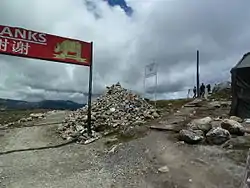| Battle of Bum La Pass | |||||||
|---|---|---|---|---|---|---|---|
| Part of Sino-Indian War | |||||||
 Indo-China border at Bum La Pass in the Zemithang circle | |||||||
| |||||||
| Belligerents | |||||||
|
|
| ||||||
| Commanders and leaders | |||||||
|
| Unknown | ||||||
| Strength | |||||||
| 20 Sikhs[1] |
200 men per wave Total:600 Chinese[2] | ||||||
| Casualties and losses | |||||||
|
19 Joginder Singh later died in Chinese captivity[1] | Most of the Army | ||||||
The Battle of Bum La Pass, also known as Battle of Bum La was fought on 23 October 1962 between Indian forces led by Subedar Joginder Singh and Chinese forces.
Background
The main cause of the war was a dispute over the sovereignty of the widely separated Aksai Chin and Arunachal Pradesh border regions. Aksai Chin, claimed by India to belong to Ladakh and by China to be part of Xinjiang, contains an important road link that connects the Chinese regions of Tibet and Xinjiang. China's construction of this road was one of the triggers of the conflict.
Battle
The post at Bum La Pass was attacked by the Chinese forces on the 23rd October 1962.[3] They were invading the town of Tawang and on the ancient path coming down from Bum La.[4] The Chinese engaged in a battle with a 19 Sikhs led by Joginder Singh. The leading battalion of the Chinese attacked in three different waves, with about 200 attacking each wave.[5] The 20 men. "...mowed down the first wave and the enemy temporarily hauled by the heavy losses it suffered".[6] Joginder asked for more ammunition from the Company HQ but the telephone line had been cut.[7] "Within a few minutes, a second wave came over and was dealt with similarly," reads the Citation of Indian Army about Joginder Singh and the battle of IB Ridge.[1] However,10 Sikhs slain.[2] During the final wave, Joginder Singh manned a machine gun and told the troops that still lived to fix their bayonets.[4] The Sikhs with bayonets led a charge and bayoneted many Chinese troops before dying.[2] It is believed that Joginder Singh single-handedly killed 56 soldiers. He was taken into Chinese captivity where he would later die.[1]
See also
References
- 1 2 3 4 Maninder Dabas (18 August 2016). "The Story of Subedar Joginder Singh – Who Crushed Waves Of Chinese Attacks At Bum La In Tawang In 1962". Indiatimes. Times Internet.
- 1 2 3 Cardozo, Ian (2003). Param Vir : our heroes in battle (1st ed.). New Delhi: Lotus Collection. ISBN 9788174362629.
- ↑ RIshi Raj (2021). 1962 INDO-CHINA WAR. Prabhat Prakashan.
- 1 2 Gurmeet Kanwal (2000). Defenders of the dawn. Lancer Publishers & Distributors. p. 81. ISBN 9788170622796.
- ↑ Pradeep Damodaran (2017). Borderlands. Hachette India. ISBN 9789351950240.
- ↑ Kittu Reddy (2007). Bravest Of The Brave Heroes Of The Indian Army. Ocean Books. ISBN 9788187100003.
- ↑ Major General V.K. Singh (2022). Signals In The 1962 War. ISBN 9788187100003.